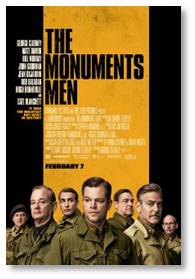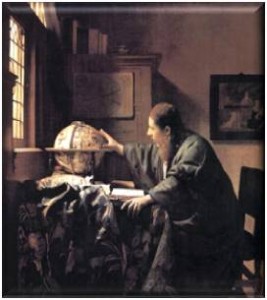 The critics are pretty much right on about the flaws in The Monuments Men—but that didn’t stop us from going or from enjoying it. It follows the exploits of the Monuments, Fine Arts, and Archives program during World War II and based on The Monuments Men: Allied Heroes, Nazi Thieves and the Greatest Treasure Hunt in History by Robert M. Edsel.
The critics are pretty much right on about the flaws in The Monuments Men—but that didn’t stop us from going or from enjoying it. It follows the exploits of the Monuments, Fine Arts, and Archives program during World War II and based on The Monuments Men: Allied Heroes, Nazi Thieves and the Greatest Treasure Hunt in History by Robert M. Edsel.
Yes, the pacing is sporadic and the tone is inconsistent. Is it a thriller, a comedy, a buddy movie, a patriotic film or all of the above? The answer, unfortunately, is “All of the Above” so you don’t know whether the next scene will make you laugh, gasp or cry. That’s not the kind of suspense that keeps viewers riveted to the screen.
BTW: The critics had a great time with humor in their reviews. In The Boston Globe, Ty Burr says @MonumentsMovie is, “. . . a tonal mishmash: Half ‘Hogan’s Post-Doctoral Heroes’, half ‘Saving Private Rembrandt’ and half ‘Ingres’s 11.’ That’s three halves, so you can see the problem.” But I award two gold stars to The Washington Post’s Anne Hornaday for her title: Raiders of the Lost Art. Very clever.
I would have gone for drama and suspense, myself, despite the comedic talents of Bill Murray, Bob Balaban, and John Goodman. There would have been enough expertise, explanation and jargon to go around and teach the audience something about art at the same time. As it is, few of the works are identified or put into any context. When the team encounters Rodin’s wonderful sculpture, The Burghers of Calais, someone simply mentions in passing that it’s a Rodin, as if he didn’t know the name or its heroic backstory.
Despite the many flaws, despite the reviews and the flaccid 33% Rotten Tomatometer score, we went to see it because I wanted to see the art that the Nazi’s were planning to take to their planned Fuhrermuseum and that the Russians would have been delighted to scarf up for the Hermitage Museum in St. Petersburg. Which paintings and which sculptures did they have in their grasp? Which ones did they torch as the Reich went down? (We’ll never really know.) What would have been lost to Western view for at least the duration of the Cold War?
Props for the Props Department
And,oh, the art! The team that provided props for The Monuments Men reproduced a number of great paintings and sculpture. Granted, recovered works could have been photographed but someone had to paint Rafael’s “Portrait of a Young Man” because that piece has been missing since the Nazis stole it from the Czartoryski Museum of Kraków in Poland.
And it’s a shock to see ordinary G.I.s handle masterworks like DaVinci’s “Lady with an Ermine,” and Vermeer’s “The Astronomer,” paintings we can see today—but only at a safe distance. The prop sculpture fared less well, though. Michaelangelo’s “Bruges Madonna” looks like the plaster it’s probably made of instead of the marvelous white Carrara marble that the great Renaissance sculptor actually used. That stone seems to hold light inside it and glows on the outside like ivory. Plaster just doesn’t measure up.
Artworks Recovered
Although the Monuments Men recovered many of the tens of thousands of stolen artworks some, like the Rafael portrait, remains missing. Lest one might despair that it will never be found, however, consider the disclosure last fall that approximately 1,400 looted artworks were recovered in the Munich apartment of Cornelius Gurlitt. The paintings and drawings, which include works by Picasso, Chagall, Munch, Gauguin, and Beckmann, are estimated to be worth more than $1 billion.
Mr. Gurlitt was the son of Hildebrand Gurlitt, a prominent dealer of modern paintings and drawings—what the Nazis called “degenerate art.” He was one of only four people whom they authorized to deal in these works of art.
The trove had actually been discovered two years earlier but the German government had kept it secret because of what they called “tax matters.” They have since been pressured by world governments to document, catalog, and display the works so that the original owners can file claims to recover them. You can see the artworks on the Lost Art Database. Plus ça change, plus c’est la même chose.
The Work Goes On
While the work done by the Monuments Men was astounding, today’s @WSJ reminds us that it continues even today, only in different parts of the world. In “The Monuments Men Are Still at It, Melik Kaylan documents the work done to protect and recover stolen art in Iraq and Afghanistan. Perhaps the movie’s sequel will follow the exploits of Marine Captain Matthew Bogdanos in the Baghdad Museum. His book is called, “Thieves of Baghdad.”
In the meantime, if you like art, enjoy seeing this cast of actors at work and don’t mind a few imperfections, go see The Monuments Men. I noticed that the audience demographic skewed heavily toward adults, but that’s a good thing.


